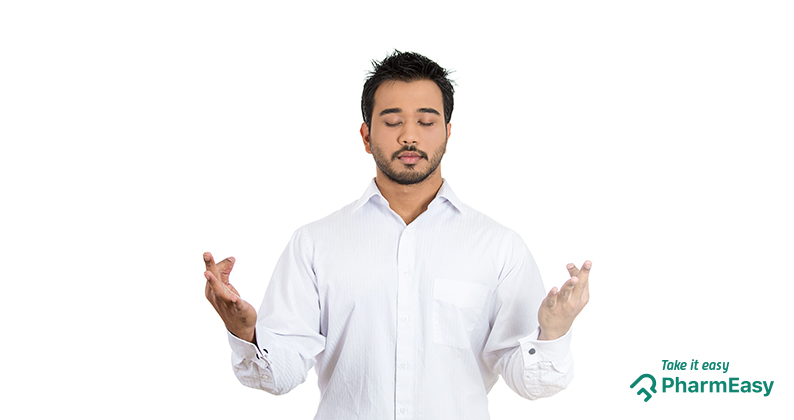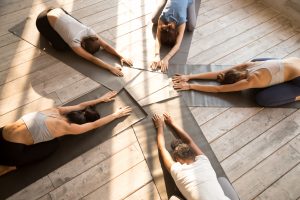7 Types Of Relaxation Techniques That Help You Fight Stress!
By Dr. Nikita Toshi +2 more

Get,

to manage your symptom
Get your,


4 Cr+ families
benefitted

OTP sent to 9988776655



You’ve successfully subscribed to receive
doctor-approved tips on
Whatsapp

Get ready to feel your best.

Hi There,
Download the PharmEasy App now!!


Register to Avail the Offer
Send OTPBy continuing, you agree with our Privacy Policy and Terms and Conditions

Hi There,
Sign up on PharmEasy now!!
Trusted by 4 crore+ families

OTP sent to 9988776655



You have unlocked 25% off on medicines




Code: NU25
By Dr. Nikita Toshi +2 more
Looking for ways to de-stress after a hard day at work? For most of us, relaxation or de-stressing means flopping on the couch and zoning out in front of the television. But that does very little to counter the damaging effects of stress on your body and mind. Instead, you should turn to different types of relaxation techniques, which can activate your body’s natural relaxation response that impedes stress, calms your mind and brings your body back into balance.
Here are a few relaxation techniques for stress reduction that work –

Table of Contents
Are you distracted? Try deep breathing. A simple yet powerful relaxation technique, deep breathing involves taking slow, long, deep breaths and as you do so, you focus on disengaging your mind from distracting sensations and thoughts. This type of breathing exercise is particularly helpful for people with eating disorders and sleep disorders, as it helps them to focus on their bodies more positively. Deep breathing exercises may help activate the parasympathetic nervous system, which controls your body’s relaxation response. There are many types of deep breathing exercises, like abdominal breathing, diaphragmatic breathing and paced respiration. These exercises can be combined with other de-stress activities, like music and aromatherapy. The best part – it is easy to learn and can be practiced anywhere.
This is a two-way process, where you systematically contract and relax different muscle groups in the body. Practising PMR (Progressive Muscle Relaxation) regularly makes you familiar with what complete relaxation feels like. This enables you to react to the initial symptoms of muscular tension accompanying stress and as your body relaxes, so does the mind.
Do you often ignore the signs your body exhibits due to stress without realizing the seriousness of the situation? This could lead to serious health issues shortly. Body scan meditation is a great way to release tension that you might not even realize your body is experiencing. The technique involves paying attention to different body parts and bodily sensations in a gradual sequence starting from the toe and then moving up to the head.
Did you know your stress levels could go down just by drawing a scenic picture in your head? Well, that’s exactly what ‘guided imagery’ does to you. For this particular relaxation technique, you imagine scenic locations and pictures in your mind to help you focus and relax. You will find plenty of recordings of soothing scenes online on free apps – all you need to do is choose the image you find calming, one that has a personal significance.
This type of relaxation technique involves sitting in a comfortable position, focusing on your breathing and directing the mind to the present moment without drifting its attention to the past or future. Mindfulness meditation can work wonders for people trying to cope with depression, anxiety or chronic pain.
Did you know people who exercise daily are less likely to experience stress and anxiety than those who don’t? This is because any sort of physical exercise reduces the level of the stress hormone, cortisol, in your body. It releases chemicals, known as endorphins, which enhance mood and act as a natural pain reliever. Moreover, exercising helps to improve the quality of sleep that is often affected negatively due to anxiety and stress. Pick an exercise routine or activity that appeals to you. Dancing, cycling, jogging and walking are some of the best de-stress activities to choose from.
Yoga is a body-mind practice, which combines controlled breathing, physical poses and relaxation or meditation. It brings about mental and physical disciplines that can help you achieve peacefulness of mind and body. This, in turn, helps you relax and manage stress and anxiety.
Breathing exercises, Progressive muscle relaxation and visualisation exercises are very helpful for assisting with sleep and reducing anxiety.
Dr. Ashish Bajaj, M.B.B.S., M.D. in Clinical Pharmacology and Toxicology

Experts suggest certain yoga postures are particularly beneficial for reducing stress. The most common and easy-to-practice poses are –
I personally recommend Biofeedback therapy to my patients which they have found very helpful. Biofeedback is a type of mind-body technique you use to control some of your body’s functions, such as your heart rate, breathing patterns and muscle responses.
Dr. M.G. Kartheeka, MBBS, MD(Pediatrics)
Stress, if not managed effectively, can take a toll on your daily life and make you susceptible to a host of health problems. Learning the basics of different types of relaxation techniques is quite easy. However, it takes regular practice to truly harness the power of relieving stress.
Disclaimer: The information provided here is for educational/awareness purposes only and is not intended to be a substitute for medical treatment by a healthcare professional and should not be relied upon to diagnose or treat any medical condition. The reader should consult a registered medical practitioner to determine the appropriateness of the information and before consuming any medication. PharmEasy does not provide any guarantee or warranty (express or implied) regarding the accuracy, adequacy, completeness, legality, reliability or usefulness of the information; and disclaims any liability arising thereof.
Links and product recommendations in the information provided here are advertisements of third-party products available on the website. PharmEasy does not make any representation on the accuracy or suitability of such products/services. Advertisements do not influence the editorial decisions or content. The information in this blog is subject to change without notice. The authors and administrators reserve the right to modify, add, or remove content without notification. It is your responsibility to review this disclaimer regularly for any changes.

Leave your comment...
Comments